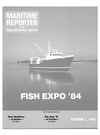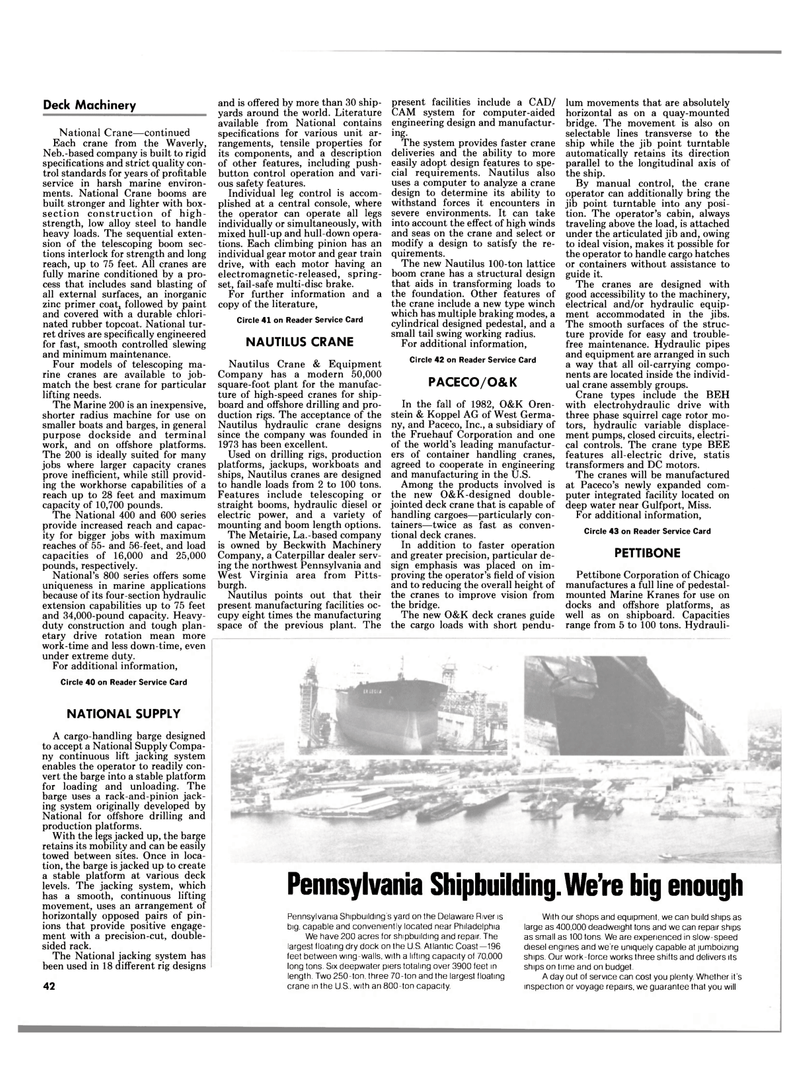
Page 44: of Maritime Reporter Magazine (October 1984)
Read this page in Pdf, Flash or Html5 edition of October 1984 Maritime Reporter Magazine
Deck Machinery
National Crane—continued
Each crane from the Waverly,
Neb.-based company is built to rigid specifications and strict quality con- trol standards for years of profitable service in harsh marine environ- ments. National Crane booms are built stronger and lighter with box- section construction of high- strength, low alloy steel to handle heavy loads. The sequential exten- sion of the telescoping boom sec- tions interlock for strength and long reach, up to 75 feet. All cranes are fully marine conditioned by a pro- cess that includes sand blasting of all external surfaces, an inorganic zinc primer coat, followed by paint and covered with a durable chlori- nated rubber topcoat. National tur- ret drives are specifically engineered for fast, smooth controlled slewing and minimum maintenance.
Four models of telescoping ma- rine cranes are available to job- match the best crane for particular lifting needs.
The Marine 200 is an inexpensive, shorter radius machine for use on smaller boats and barges, in general purpose dockside and terminal work, and on offshore platforms.
The 200 is ideally suited for many jobs where larger capacity cranes prove inefficient, while still provid- ing the workhorse capabilities of a reach up to 28 feet and maximum capacity of 10,700 pounds.
The National 400 and 600 series provide increased reach and capac- ity for bigger jobs with maximum reaches of 55- and 56-feet, and load capacities of 16,000 and 25,000 pounds, respectively.
National's 800 series offers some uniqueness in marine applications because of its four-section hydraulic extension capabilities up to 75 feet and 34,000-pound capacity. Heavy- duty construction and tough plan- etary drive rotation mean more work-time and less down-time, even under extreme duty.
For additional information,
Circle 40 on Reader Service Card
NATIONAL SUPPLY
A cargo-handling barge designed to accept a National Supply Compa- ny continuous lift jacking system enables the operator to readily con- vert the barge into a stable platform for loading and unloading. The barge uses a rack-and-pinion jack- ing system originally developed by
National for offshore drilling and production platforms.
With the legs jacked up, the barge retains its mobility and can be easily towed between sites. Once in loca- tion, the barge is jacked up to create a stable platform at various deck levels. The jacking system, which has a smooth, continuous lifting movement, uses an arrangement of horizontally opposed pairs of pin- ions that provide positive engage- ment with a precision-cut, double- sided rack.
The National jacking system has been used in 18 different rig designs 42 and is offered by more than 30 ship- yards around the world. Literature available from National contains specifications for various unit ar- rangements, tensile properties for its components, and a description of other features, including push- button control operation and vari- ous safety features.
Individual leg control is accom- plished at a central console, where the operator can operate all legs individually or simultaneously, with mixed hull-up and hull-down opera- tions. Each climbing pinion has an individual gear motor and gear train drive, with each motor having an electromagnetic-released, spring- set, fail-safe multi-disc brake.
For further information and a copy of the literature,
Circle 41 on Reader Service Card
NAUTILUS CRANE
Nautilus Crane & Equipment
Company has a modern 50,000 square-foot plant for the manufac- ture of high-speed cranes for ship- board and offshore drilling and pro- duction rigs. The acceptance of the
Nautilus hydraulic crane designs since the company was founded in 1973 has been excellent.
Used on drilling rigs, production platforms, jackups, workboats and ships, Nautilus cranes are designed to handle loads from 2 to 100 tons.
Features include telescoping or straight booms, hydraulic diesel or electric power, and a variety of mounting and boom length options.
The Metairie, La.-based company is owned by Beckwith Machinery
Company, a Caterpillar dealer serv- ing the northwest Pennsylvania and
West Virginia area from Pitts- burgh.
Nautilus points out that their present manufacturing facilities oc- cupy eight times the manufacturing space of the previous plant. The present facilities include a CAD/
CAM system for computer-aided engineering design and manufactur- ing.
The system provides faster crane deliveries and the ability to more easily adopt design features to spe- cial requirements. Nautilus also uses a computer to analyze a crane design to determine its ability to withstand forces it encounters in severe environments. It can take into account the effect of high winds and seas on the crane and select or modify a design to satisfy the re- quirements.
The new Nautilus 100-ton lattice boom crane has a structural design that aids in transforming loads to the foundation. Other features of the crane include a new type winch which has multiple braking modes, a cylindrical designed pedestal, and a small tail swing working radius.
For additional information,
Circle 42 on Reader Service Card
PACECO/O&K
In the fall of 1982, O&K Oren- stein & Koppel AG of West Germa- ny, and Paceco, Inc., a subsidiary of the Fruehauf Corporation and one of the world's leading manufactur- ers of container handling cranes, agreed to cooperate in engineering and manufacturing in the U.S.
Among the products involved is the new O&K-designed double- jointed deck crane that is capable of handling cargoes—particularly con- tainers—twice as fast as conven- tional deck cranes.
In addition to faster operation and greater precision, particular de- sign emphasis was placed on im- proving the operator's field of vision and to reducing the overall height of the cranes to improve vision from the bridge.
The new O&K deck cranes guide the cargo loads with short pendu- lum movements that are absolutely horizontal as on a quay-mounted bridge. The movement is also on selectable lines transverse to the ship while the jib point turntable automatically retains its direction parallel to the longitudinal axis of the ship.
By manual control, the crane operator can additionally bring the jib point turntable into any posi- tion. The operator's cabin, always traveling above the load, is attached under the articulated jib and, owing to ideal vision, makes it possible for the operator to handle cargo hatches or containers without assistance to guide it.
The cranes are designed with good accessibility to the machinery, electrical and/or hydraulic equip- ment accommodated in the jibs.
The smooth surfaces of the struc- ture provide for easy and trouble- free maintenance. Hydraulic pipes and equipment are arranged in such a way that all oil-carrying compo- nents are located inside the individ- ual crane assembly groups.
Crane types include the BEH with electrohydraulic drive with three phase squirrel cage rotor mo- tors, hydraulic variable displace- ment pumps, closed circuits, electri- cal controls. The crane type BEE features all-electric drive, statis transformers and DC motors.
The cranes will be manufactured at Paceco's newly expanded com- puter integrated facility located on deep water near Gulfport, Miss.
For additional information,
Circle 43 on Reader Service Card
PETTIBONE
Pettibone Corporation of Chicago manufactures a full line of pedestal- mounted Marine Kranes for use on docks and offshore platforms, as well as on shipboard. Capacities range from 5 to 100 tons. Hydrauli-
Pennsylvania Shipbuilding. We're big enough
Pennsylvania Shipbuilding's yard on the Delaware River is big. capable and conveniently located near Philadelphia
We have 200 acres for shipbuilding and repair The largest floating dry dock on the U.S. Atlantic Coast—196 feet between wing-walls, with a lifting capacity of 70,000 long tons. Six deepwater piers totaling over 3900 feet in length. Two 250-ton. throe 70-ton and the largest floating crane in the U.S.. with an 800-ton capacity.
With our shops and equipment, we can build ships as large as 400,000 deadweight tons and we can repair ships as small as 100 tons. We are experienced in slow-speed diesel engines and we're uniquely capable at jumboizing ships. Our work-force works three shifts and delivers its ships on time and on budget.
A day out of service can cost you plenty. Whether it's inspection or voyage repairs, we guarantee that you will

 43
43

 45
45
